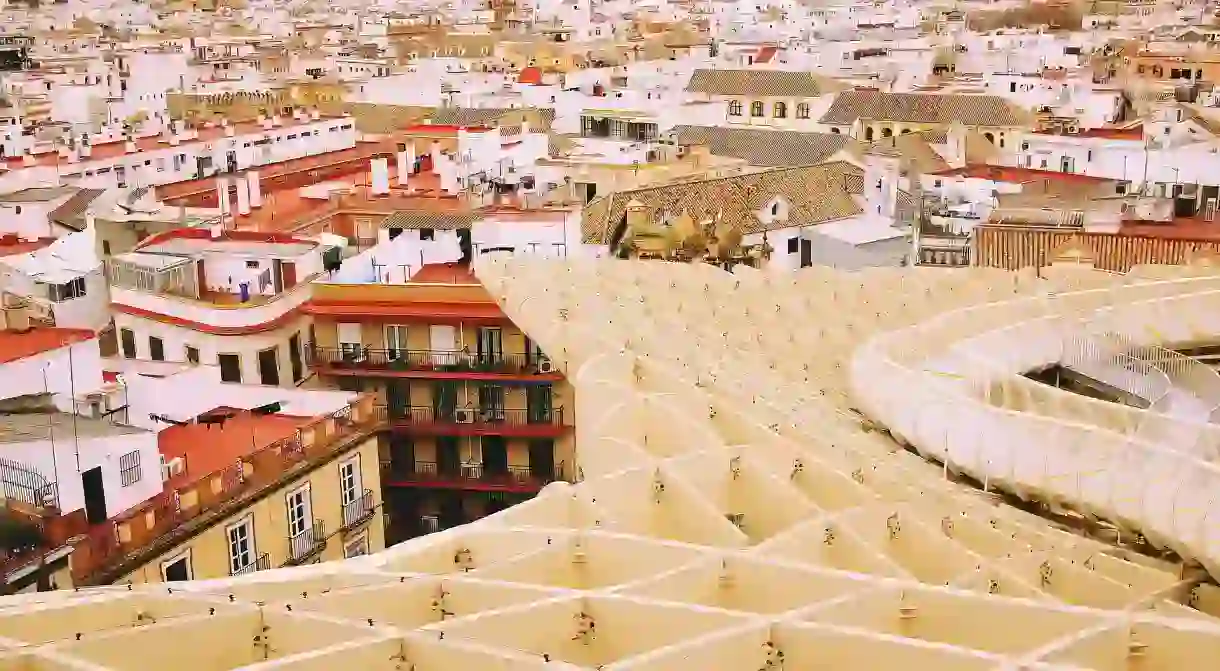How to Spend two days in Seville

No me ha dejado, they say of Seville: “it has not forsaken me.” The Andalusian capital is, without doubt, one of Europe’s most attractive and enchanting cities. On a 48-hour mini-break, you will find plenty to make your visit here linger fondly in the memory long after leaving, just as the city’s motto promises.
Wandering in Santa Cruz and Triana
Seville surrenders its charms and secrets to the aimless wanderer. The majority of your first day in the Andalusian capital couldn’t be better spent than on foot, exploring the old Jewish quarter of Santa Cruz and the gyspy quarter of Triana. Santa Cruz is the scrunched-together maze of narrow streets that surrounds Seville’s cathedral and Alcázar; although it is the busy touristic center of Seville, it has kept all of the charm that has seduced visitors for centuries. Eschew the touristy (and expensive) horse-drawn taxis that hang around the cathedral in order to be able to nose around Santa Cruz properly: many of the streets are so narrow that there’s barely enough room for two pedestrians side-by-side, let alone a horse and carriage.

Cross the San Telmo Bridge
After getting lost in Santa Cruz, cross the ornate San Telmo bridge to the other side of the distinctively pale-green Guadalquivir river. On this side of town, the ambience changes slightly but definitely as you enter the romance-drenched gypsy neighborhood of Triana. Bullfighting and flamenco are deeply associated with this achingly pretty quarter, the colorful houses of which are decorated with locally-made ceramics. These are on sale in many of barrio’s independent shops, which sit next to old-style tapas bars – plastered with huge old bullfighting posters and bursting with local life – on the scruffy, beautiful streets. While you’re in Triana, don’t miss the recently-renovated covered market – another superb place to sample Triana culture.
Read about the amazing matadors
In his fascinating autobiography, the legendary Triana-born gypsy matador Juan Belmonte recounts his rebellious childhood. He remembers hanging around the Alameda de Hércules in the early 1900s, smoking with his deliquent friends and openly-mocking passers-by. Characters such as the young Belmote gave this spacious plaza a bad reputation for the rest of the century, and until recently it was a sinister area which visitors were recommended to leave well alone. Things couldn’t be more different now: Plaza Alameda is one of the city’s most popular nightspots, and is packed with fashionable bars and restaurants offering a range of international cuisine as well as traditional Andalusian fare. And after a day’s wandering, you will need a good meal.
Seeing the sights
Kick off the second half of your 48 hours in Seville with a trip to the Metropol Parasol monument in the heart of the city center. This amazing wooden sculpture was built between 2005 and 2011 and is locally referred to as Las Setas, or “the mushrooms” due to the distinctive shape of its vast canopies. It is perched delicately above Roman ruins – a fact which made construction a lengthy and controversial project – that are viewable in the ground-floor’s archaeological musem, while a rooftop walkway offers panoramic views of the city.From the mushrooms it’s but a five minute walk to Seville’s two key historic attractions. The Cathedral of Saint Mary of the See is the largest Gothic cathedral and third largest church in the world. Construction of this sprawling complex commenced in 1401 and continued for over a hundred years. In 1507 the cathedral was finally opened, quite spectacularly succeeding in its original aim – namely, to show the rest of Europe how powerful and wealthy Seville had become.

All over Andlausia, displays of Catholicism might sit alongside great monuments from the region’s Moorish period. Seville is no exception, with its Moorish Alcázar palace located just a few minutes on foot from the huge cathedral. Though considered one of the finest examples of Moorish architecture in Spain, the Alcázar’s various sections in fact have differing styles and date from the Mudéjar and Renaissance periods as well as from the city’s time under Moorish rule.
Soak it all in
For a suitably romantic conclusion to your second day in this enchanting city, head to the banks of the Guadalquivir river for the sunset. Flowing from Córdoba through inland Andalusia, Seville and eventually out into the Atlantic ocean, the Guadalquivir has the only river port in Spain and brought Seville great wealth after Columbus discovered the New World in 1492. Reflected in its slow-moving waters, the lights of Triana lend sunsets here a beauty that will stay with you for a long time after leaving. Seville, indeed, will not forsake you.













